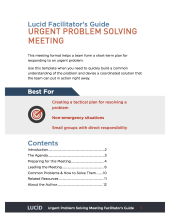You can find an introduction to Problem Solving Meetings in Chapter 25 of Where the Action Is. These resources will help you plan, run, and troubleshoot the specific Problem Solving Meetings your team needs.
Definition
Teams use Problem Solving Meetings to analyze a situation and its causes, assess what direction to take, then create an action plan to resolve the problem.
Questions Answered
- What do we know about the problem?
- What are our options?
- What are we going to do to address it?
Examples
- Incident Response
- Strategic Issue Resolution
- Major Project Change Resolution
Core Process
Most problem solving meetings include these steps.
- Problem Definition
- Solution Goals & Constraints
- Identify Possible Solutions
- Select Approach
- Define Action Plan
- Confirm Next Steps
Purpose
- Find a solution to a problem.
- Secure commitment to enact the solution.
Work Outcomes
- A solution or possible solution options.
- Clarity about who will do what by when.
- A scheduled check-in time.
Human Outcomes
- Understanding of the problem’s scope.
- A path forward—getting unstuck.
- Support for tackling the problem.
Meeting Agenda Templates and Guides
How to Access the Wisdom of Your GroupPaul Axtell - Seeking input from colleagues is different from the typical approach to group problem solving. Problem solving is a back-and-forth conversation. Seeking input from colleagues is a reflective exercise built around observing your colleagues discuss a problem or idea.At the heart of this meeting agenda template design... [ more ] |
|
How to Run an Urgent Problem Solving MeetingElise Keith - This meeting agenda template helps a team find short-term tactical solutions to an urgent problem. The conversation includes time to gain a shared understanding of the problem, but focuses primarily on listing and evaluating possible solutions and the creation of a short- term action plan. Use this meeting to... [ more ] |
Recommended Reading & Resources
Blog Posts
- "The five keys to a successful Google team", Julia Rozovsky (2015).
Videos
- Building a psychologically safe workplace. Amy Edmondson (2014).
- Dr. Daniel Siegel’s Hand Model of the Brain. Danie Siegel (2012).
Glossary of Meeting Terms
Technique
The 5 Whys is a technique used to determine the root cause of an issue. By repeatedly asking the question “Why” (five is a good rule of thumb), you can discover symptoms which may lead to the reason a problem exists...
Argument Mapping is a technique for graphically breaking down and showing the reasoning (or argument) behind a statement. In a meeting, groups can use Argument Mapping to explore the underlying assumptions behind a...
Creative Problem Solving (CPS) is a method that attempts to approach a problem or a challenge in an innovative way. The process helps redefine problems and opportunities to come up with new responses and solutions....
A fishbone diagram is a visual technique that teams use to organize their thinking and identify causes for a problem. The diagram starts with a process or problem written at the right center of the board, with a long...
Teams conduct a force field analysis when they need to make go/no-go decisions. Teams start by writing the proposed change down the center of the diagram. To the left, they list the forces driving change, with an...
A Pareto Analysis is a decision-making technique used to choose a limited number of actions to take that will result in a significant impact. The analysis uses the Pareto Principle (the 80/20 rule), which states for...
The term Round Robin is used to refer to two distinct techniques.
For some, a "round robin" is just another name for a go around.
For others, a round robin is a specialized brainwriting technique in which everyone...
SCAMPER is a creative thinking and problem-solving technique that guides groups to evaluate an idea by exploring similar or related ideas. SCAMPER stands for:
Substitute: looking at what can be switched out in...
Six Serving Men is a team exercise that examines an issue from twelve different viewpoints. It is based on the words of the poem by Rudyard Kipling:
I keep six honest serving men, they taught me all I knew.
Their...
There are multiple meeting and thinking techniques called TRIZ.
Liberating Structures describes TRIZ as meeting exercise designed to help groups identify counterproductive things they may be doing and find ways to...

